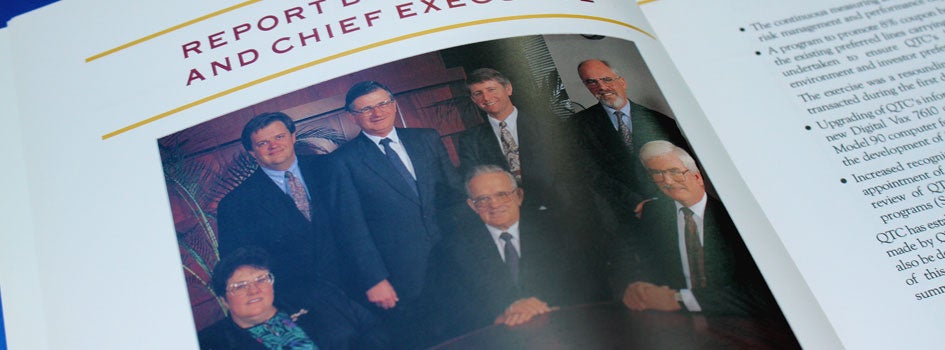History - 1988-1992
Extracting economies of scale

Queensland Treasury Corporation (QTC) was established on 1 July 1988 as a division of the Queensland Treasury Department, assuming the central borrowing authority role of its predecessor, the Queensland Government Development Authority. Its function was to maximise value for the State and its entities, by making it more efficient and less risky for the State and its public sector bodies to benefit from the advantages associated with operation in global wholesale debt and investment markets. By extracting economies of scale, QTC acted in the interests of Queensland, providing professional solutions to complex financing problems to ensure Queensland’s future financial success.
Following a review in 1990, QTC was restructured on 1 July 1991 as a separate, autonomous and accountable central financing authority. This involved separating QTC from the Department, transferring responsibility for the State’s wholesale and medium- to long-term investments to the Queensland Investment Corporation (QIC), and establishing the QTC Capital Markets Board, with Sir Leo Hielscher AC as Chairman.
Back to topThe formation of QTC

In the late 1980s, there was further substantial deregulation of financial markets, both in Australia and abroad. While this deregulation led to increased volatility it presented opportunities, to provide professional financial management for those participating in the markets.
Following the recommendations by the Campbell Report, the need for a central borrowing authority was further enhanced by the Queensland Government’s review of evidence demonstrating the superior long-term performance of diversified investment portfolios, including shares and property as well as interest-bearing investments, compared with portfolios comprising interest-bearing investments alone.
The previous experience of the Queensland Treasury Department and the Queensland Government Development Authority (QGDA) provided a sound base from which a more integrated funds management approach could be built. In the context of the existing operating environment, an alternative model was required to compete more effectively and efficiently as financial markets continued to evolve and develop.
Against this background, in April 1988, the Queensland Government announced the establishment of Queensland Treasury Corporation (QTC)—a new Government financial institution offering a complete range of financial services to the State Government and its statutory bodies.
Following the drafting process, QTC’s governing legislation—the Queensland Treasury Corporation Act 1988 (the Act)—was passed, with assent granted on 5 May 1988. On 30 June 1988, the QGDA ceased its activities and, on the next day (1 July 1988), QTC formally began operations.
Prior to the Act’s assent, then Under Treasurer Sir Leo Hielscher AC retired from the Queensland public service, before assuming his new position as Chairman of QTC on 1 July 1988. Sir Leo was joined by Stephen Rochester, who was appointed Chief Executive of the new entity.
Back to topQTC's initial operations

QTC brought together the previous financial operations of the QGDA and the Investment Branch of the Queensland Treasury Department, as well as providing a vehicle for the provision of a wide range of other financial services.
The cornerstone of its operations policy was the management of financial risks through risk diversification, using the principles of modern portfolio theory. The appropriateness of this policy was reinforced by the results achieved by the QGDA with its foreign currency borrowings, where the principles of portfolio theory were applied to the management of the currency risks associated with such borrowings.
To optimise its operations, QTC had (under its legislation) a full range of financial powers and the capacity to exercise those powers at its discretion. This legislation enabled QTC to meet its objectives—to act as a financial institution for statutory bodies and the State, and provide them with financial resources and services. QTC’s objectives also included a requirement to enhance the financial position of the Corporation, other statutory bodies and the State, and to enter into financial arrangements that advance the financial interests and development of the State or persons resident or associated with Queensland. Ultimately, QTC was responsible to the Queensland Government for its performance.
As a consequence of its broad responsibilities, the reporting and accountability structure of QTC was initially divided into four functional streams: Investment Portfolio Management, Capital Markets Operations, Other Financial Services and Administration.
Back to topInvestment Portfolio Management

The Investment Portfolio Management function managed investment of those assets that related to long-term obligations of the State, mainly Queensland public sector superannuation funds. The Investments Board, appointed on 23 March 1989 with James Kennedy CBE as its Chairman, oversaw the investment portfolio management function of QTC. The Investment Trust, established on 1 July 1988, was one of the largest investment funds to be established in Australia.
Back to topCapital Markets Operations

Liability and funds management was overseen by the Capital Markets Advisory Board, chaired by Sir Leo Hielscher AC. The amalgamation of the debt of local authorities and statutory bodies, and the efficient management of that debt to the financial benefit of the authorities, was the primary function of the Capital Markets Advisory Board.
Alongside this function, the Capital Markets Advisory Board used its knowledge and expertise in international money markets to fulfil the role of cash asset manager for the Government and other authorities’ cash funds, as requested. QTC was responsible for managing the liabilities incurred by participating statutory authorities in funding their capital works programs.
Back to topOther financial services

This stream managed other financial services provided by QTC to the Government, local authorities and other statutory bodies. The scope of these financial services reflected the deregulation of financial markets in Australia and QTC’s ability to provide financial services that were offered by other financial agencies in other states.
Administration
Administration provided support services for the operations of both the Capital Markets Advisory Board and the Investments Board, as well as other financial services undertaken by QTC.
Back to topConsolidating State debt and accessing offshore funding

Two of the successes of QTC’s predecessor, the Queensland Government Development Authority (QGDA), were the centralisation of financial management for the majority of Queensland’s 300 authorities and statutory bodies, and the building of a strong foundation of competencies involving the sourcing of offshore funding.
While the latter success grew from strength-to-strength, ultimately the centralisation of financial management services became unwieldy, with several hundred State authorities and statutory bodies competing for individual debenture packages with significant establishment and interest costs. With the foundation of QTC, a unique solution was available: the consolidation of all State debt into one central funding pool.
In its initial years, QTC focused on this task: consolidating the State’s debt and taking on the role as Queensland’s single debt issuer. This way, QTC rationalised the number of approaches to the debt markets and eliminated competition between the various issuing local and semi-government authorities. The economies of scale generated by this consolidation, together with QTC’s commitment to open and transparent communication with the markets, translated into well sought-after, liquid debt that provided clients with a comparatively low cost of funds.
QTC, upon its foundation, also became responsible for sourcing offshore funding, a task previously undertaken by the QGDA. Success in the international trading market required not only a minimum level of credit quality, but also a minimum sustainable and recurrent level of activity in the market place to attract investors to allocate their resources and equity to Queensland. QTC, having calculated that an initial consolidated debt figure of approximately $12 billion would be an attractive target for offshore investors, began the careful process of creating enough liquidity in the market to encourage investors to trade commercial paper and drive the market forward.
Initially, QTC’s major clients such as the Brisbane City Council, the State’s electricity industry bodies and Queensland Rail agreed to transfer existing loans to QTC, and were followed over the next three years by most of the State’s other authorities and statutory bodies. The Australian Government also ultimately agreed to transfer Queensland’s debt back to the control of QTC and, within a matter of years, this State-wide debt consolidation enabled QTC to create its first significant innovation: a portfolio of loans with similar terms called debt pools. Acknowledging that most clients were primarily concerned with the cost of their financing and associated risk over time, QTC’s multiple debt pool structure ensured greater flexibility and reduced risk to its clients.
This sense of innovation and unique approach to tailored product offerings has continued through QTC’s development and growth. Today, QTC continues to evolve in response to the demands of the changing financial markets and the dynamic environment in which its clients operate, to provide the most effective and efficient source of funds for its clients, and achieve whole-of-State outcomes.
Back to topFunding World Expo 88

In 1988, QTC provided funding (using commercial paper facilities) for World Expo ’88, also known as Expo ’88, held in Brisbane, Queensland. This ‘World’s Fair’ was held across a six month period from April to October, with the theme of ‘Leisure in the Age of Technology’. Expo ’88 provided the centrepiece to Australia’s 1988 Bicentennial celebrations, successfully promoting both the State and Australia as a destination for tourism, trade and investment.
The site for Expo ’88 required major development of a prime area of Brisbane riverfront land on the south bank of the Brisbane River. The funds provided by QTC allowed for rehabilitation and development of the site, which was previously industrial. At the completion of Expo, the enhanced value of the land was greatly in excess of any debt outstanding, after revenues were applied.
The redevelopment of the site also sparked new life into Brisbane and the South Bank precinct. Today, the area, now known as the South Bank Parklands, is an integral part of Brisbane’s central business district and is a key attraction for domestic and international visitors to the city.
Back to topQueensland Events Corporation-racing ahead

Queensland Events Corporation Pty Ltd was established in February 1989 by the Queensland Government, to maximise the economic and development opportunities for the State presented through the hosting of major events. QTC held a 100 per cent beneficial interest in the company, with funding for its establishment through a Government loan from QTC.
During its first full year of operations in 1989-90, Queensland Events Corporation entered into an agreement with Championship Auto Racing Teams Inc. for the staging of the first event of the PPG Indy World Series at Surfers Paradise, Gold Coast, Queensland, from 15-17 March, 1991. This event, which ran for a number of years on the Gold Coast, brought Indy car racing to Queensland and provided a significant opportunity for the marketing of Queensland and the Gold Coast to a large audience of national and international visitors.
Back to topThe Queensland Nickel Joint Venture

Prior to 1989, the Queensland Government met some of the financial obligations of the companies involved in the Yabulu Nickel Refinery and the Greenvale Nickel Mine. The Government then swapped these obligations for a 12.5 per cent share in the refinery and the mine. This shareholding was held by NRNQ Pty Ltd, in which QTC owned a 95 per cent interest.
On the sale of its interest, the Government realised substantial profits as well as recovering its initial investment of almost $200 million—a successful outcome for all Queenslanders.
Back to topThe HOME scheme

In 1989, the Queensland Government’s Department of Housing put forward a proposal to extend the New South Wales Government’s First Australian National Mortgage Acceptance Corporation (FANMAC) to include Queensland’s low-income homeowners.
An extensive assessment of alternative Secondary Mortgage Market proposals, including a review of structures used in other states, concluded that the premium currently paid to investors to accept prepayment risk on pass-through securities was excessive, and that the State would benefit from bearing this risk with the pass-through premiums saved forming a reserve for any future losses.
In August 1990, the Queensland Government launched the Home Ownership Made Easier scheme (HOME), consisting of two products – HOME Low Start Loans, and the HOME Shared Scheme. The HOME scheme was a low-income program that monitored repayment rates to inform hedging choices for cash flows. By using QTC’s own bonds and putting in place a delta hedging operation for the variable component of the repayment, the Queensland Government considerably reduced mortgage risks and costs, and managed the financing requirements within a strong regulatory framework.
The adoption of QTC’s HOME scheme demonstrated QTC’s capacity to provide unique, tailored solutions to complex financial problems. QTC’s expertise plays a pivotal role in the growth of Queensland and, through its financial and risk management services, it works to deliver optimal financial outcomes for its clients and the State alike.
Back to topGoing global-the Transferable Registered Note (TRN) issuance program

From its inception, QTC had been active in international capital markets. The most notable issue in its early years was the establishment by QTC of its AUD$500 million global Transferable Registered Note (TRN) issuance program in May 1990. The program provided for the issue of Australian dollar denominated notes in international capital markets, which were freely transferable into one of QTC’s preferred lines of domestic inscribed stock. As at 30 June 1990, a total of $410 million in stock had been issued.
This program was innovative in its structure and was the world’s first truly global public debt issuance program, being the first debt issuance to have been fully registered in the United States and listed on the London Stock Exchange. QTC was the first semi-government to issue its preferred lines of inscribed stock in global markets at yields below domestic funding costs. QTC’s global bonds were withholding tax free for foreign investors which meant they did not pay the 10% interest withholding tax on the bond coupon payments. As a general rule QTC issued its global bonds at a margin around 7 basis points below QTC’s domestic benchmark bonds (ie. a lower yield or higher price). Due to its success, the size of the program was increased in the 1990-91 financial year to AUD $1.5 billion.
Back to topEstablishing the QTC Capital Markets Board

Upon the establishment of QTC, and because of the extent and diversity of its operations, two Advisory Boards were established—the Capital Markets Board and the Investments Board. The Under Treasurer, as QTC’s shareholder, delegated certain powers to these Boards in relation to borrowings and investments by QTC. To 30 June 1991, QTC was responsible for the management of two asset portfolios; the Cash Fund, on behalf of QTC debt participants, and the Term Fund, on behalf of the QTC Investment Trust.
In 1991, QTC underwent one of its first major transformations. Following studies by the Queensland Government, the initial steps were taken during the year to ensure clear independence between the separate roles of the Capital Markets Division and the Investments Division of QTC. These steps involved the transfer of QTC’s asset management function to the new Queensland Investment Corporation (QIC), and also involved the separation of QTC from the Queensland Treasury physically and functionally, with clearly defined liability management objectives and responsibilities.
On 1 July 1991, the portfolio investment functions undertaken through the Investments Board became the responsibility of Queensland Investment Corporation (QIC) under the Queensland Investment Corporation Act 1991. QIC’s function was to manage the assets of the QTC Investment Trust (renamed the QIC Investment Trust from the 1 July 1991). In this context, QIC, a Government-owned corporation, assumed the management of the Trust’s portions of the Term Fund and Cash Fund as well as its offshore investment exposure. QTC continued with the management of the remaining Term and Cash Fund assets.
The QTC Capital Markets Board was established to oversee the operations of the restructured QTC and, in August 1991, Sir Leo Hielscher AC was appointed inaugural Chairman. Sir Leo remained at the helm of the QTC Capital Markets Board until his retirement on 11 February 2010, after seven consecutive terms.
Back to topThe issue of issuance

One of QTC’s early goals was to build the capacity to issue every type of instrument in every market and every currency in the world. Accordingly, a framework was established to be able to issue domestic volumes in one stream, commercial paper in another, and medium-term notes in a third stream, with registrations in Japan, the United States, and Europe, and listings in London and, later, Luxembourg. With exposure to the liquid Australian dollar, a demonstrated market, and a reasonable security of supply, QTC’s products quickly became an attractive investment.
To facilitate funding diversification and provide a global reach, QTC established its Fixed Income Distribution Group (FIDG) in 1988. This was a dedicated group of banks (domestic and global) tasked with marketing and selling QTC’s funding facilities to investors around the world. Importantly it created secondary market liquidity, or price support, for QTC’s benchmark bonds so that investors were confident that they could buy or sell as and when they needed. With this confidence, QTC was able to ensure the best possible price was reached for its issues—ultimately lowering QTC’s cost of funds. At this time, it was also important to provide investors with confidence in the liquidity of QTC bonds—given QTC’s recent entry in the Australian market it gave investors added confidence to invest in QTC. Establishing FIDG has provided long-term benefit, with the group having an in-depth understanding of QTC and Queensland.
In its early days, QTC achieved many firsts. In the late 1980s, QTC was the first to establish a global transferable note (TRN) program, specifically targeted at offshore investors, and to issue global bonds at yields below those achievable in the domestic market. This pricing benefit arose because the QTC bonds issued under the Global TRN program were withholding tax free for offshore investors and as a consequence these bonds were able to be issued around 7 basis points below the yield of domestic benchmark bonds. In April 1992, QTC established a multi-currency Euro Medium-Term Note Program and a multi-currency United States Medium-Term Note Program to supplement the Global TRN program and take immediate advantage of any foreign currency and Australian dollar opportunities that may have arisen.
In 1993, QTC promoted its 8 per cent Coupon Domestic A$ Bonds as the primary preferred lines. QTC offered investors an opportunity to switch from 12 per cent and 10.5 per cent Coupon Domestic A$ Bonds of a similar maturity. A highly successful strategy, the amount of the switch ($4 billion) resulted in an immediate reduction in interest yields of between 3 and 4 basis points.
Today, QTC maintains an innovative approach to providing long-term access to competitively-priced funds. QTC’s key funding principles demonstrate a commitment to its investors and partners in the financial markets. The global approach to borrowing and whole-of-State focus enable QTC to capture significant economies of scale and scope in the issuance, management and administration of debt.
Back to top